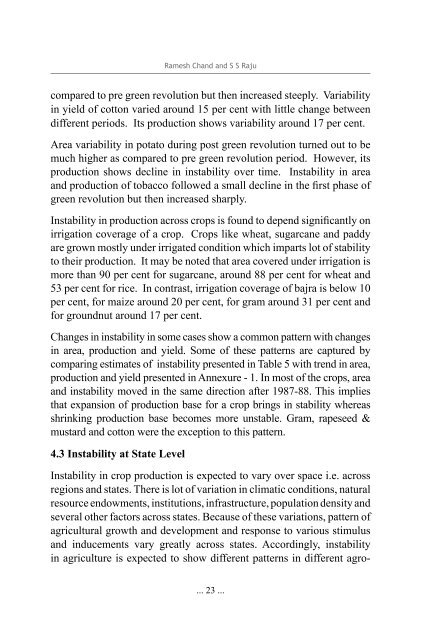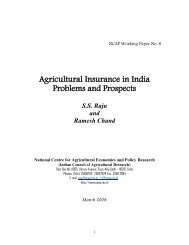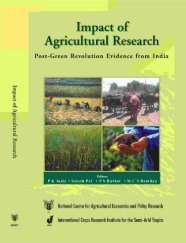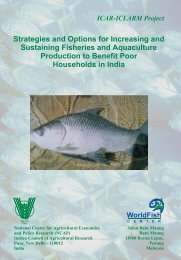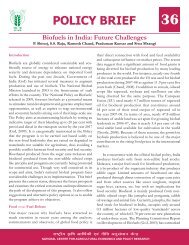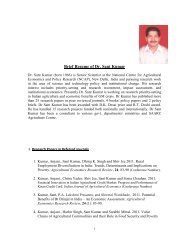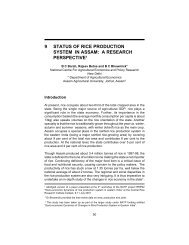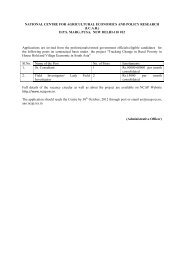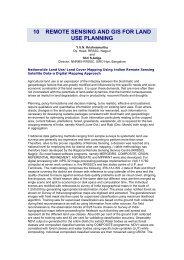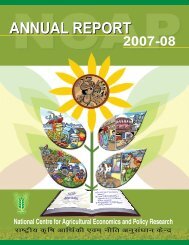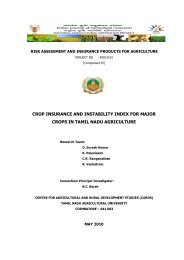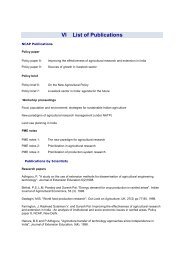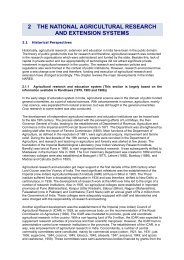Instability in Indian Agriculture - NCAP
Instability in Indian Agriculture - NCAP
Instability in Indian Agriculture - NCAP
Create successful ePaper yourself
Turn your PDF publications into a flip-book with our unique Google optimized e-Paper software.
Ramesh Chand and S S Raju<br />
compared to pre green revolution but then <strong>in</strong>creased steeply. Variability<br />
<strong>in</strong> yield of cotton varied around 15 per cent with little change between<br />
different periods. Its production shows variability around 17 per cent.<br />
Area variability <strong>in</strong> potato dur<strong>in</strong>g post green revolution turned out to be<br />
much higher as compared to pre green revolution period. However, its<br />
production shows decl<strong>in</strong>e <strong>in</strong> <strong>in</strong>stability over time. <strong>Instability</strong> <strong>in</strong> area<br />
and production of tobacco followed a small decl<strong>in</strong>e <strong>in</strong> the first phase of<br />
green revolution but then <strong>in</strong>creased sharply.<br />
<strong>Instability</strong> <strong>in</strong> production across crops is found to depend significantly on<br />
irrigation coverage of a crop. Crops like wheat, sugarcane and paddy<br />
are grown mostly under irrigated condition which imparts lot of stability<br />
to their production. It may be noted that area covered under irrigation is<br />
more than 90 per cent for sugarcane, around 88 per cent for wheat and<br />
53 per cent for rice. In contrast, irrigation coverage of bajra is below 10<br />
per cent, for maize around 20 per cent, for gram around 31 per cent and<br />
for groundnut around 17 per cent.<br />
Changes <strong>in</strong> <strong>in</strong>stability <strong>in</strong> some cases show a common pattern with changes<br />
<strong>in</strong> area, production and yield. Some of these patterns are captured by<br />
compar<strong>in</strong>g estimates of <strong>in</strong>stability presented <strong>in</strong> Table 5 with trend <strong>in</strong> area,<br />
production and yield presented <strong>in</strong> Annexure - 1. In most of the crops, area<br />
and <strong>in</strong>stability moved <strong>in</strong> the same direction after 1987-88. This implies<br />
that expansion of production base for a crop br<strong>in</strong>gs <strong>in</strong> stability whereas<br />
shr<strong>in</strong>k<strong>in</strong>g production base becomes more unstable. Gram, rapeseed &<br />
mustard and cotton were the exception to this pattern.<br />
4.3 <strong>Instability</strong> at State Level<br />
<strong>Instability</strong> <strong>in</strong> crop production is expected to vary over space i.e. across<br />
regions and states. There is lot of variation <strong>in</strong> climatic conditions, natural<br />
resource endowments, <strong>in</strong>stitutions, <strong>in</strong>frastructure, population density and<br />
several other factors across states. Because of these variations, pattern of<br />
agricultural growth and development and response to various stimulus<br />
and <strong>in</strong>ducements vary greatly across states. Accord<strong>in</strong>gly, <strong>in</strong>stability<br />
<strong>in</strong> agriculture is expected to show different patterns <strong>in</strong> different agro-<br />
... 23 ...


